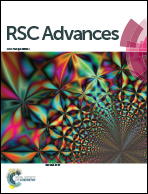Packing directed beneficial role of 3-D rigid alicyclic arms on the templated molecular aggregation problem†
Abstract
Subtle changes in molecular structure have been used to alter the molecular packing and optical properties of organic luminophores. Thus it is important to study simple and advantageous structural modification to overcome limitations of aggregation quenching of fluorescence. Planar conjugated organic compounds are unlikely to be used in OLED devices as they suffer with luminescence weakening due to π–π cofacial stacking and excimer formation in the solid state. To avoid such critical issues, doped device architecture for OLED devices has widely been adopted which actually complicates the device fabrication process. Thus an approach for delimiting these drawbacks using simple methodologies is highly desirable for cost effective OLED device fabrication. In this context, two 3-dimensional rigid arms have been introduced into a planar benzo[h]chromen-2-one core, which suffers from aggregation caused quenching, as peripheral substituents to tune the molecular packing and subsequently their optical properties. The resultant compounds 1 and 2 have been tested for non-doped and doped OLED device application. Compound 1 was found to be highly thermally stable with a decomposition temperature of 344 °C. Single crystal XRD studies helped to elucidate that voluminous ring substituents are capable of eradicating co-facial π–π stacking by increasing the intermolecular distance and hence the luminescence in the solid state could be regenerated. This tuning of intermolecular distance between molecules helped to mitigate the close packed arrangement at a molecular level and also provided the bulk with the enhanced emission property. Electroluminescence from a pristine layer of compound 1 was possible. Thus an approach enabling planar luminophores to be used in OLED applications utilizing thin films of structurally engineered luminophores has been presented.


 Please wait while we load your content...
Please wait while we load your content...